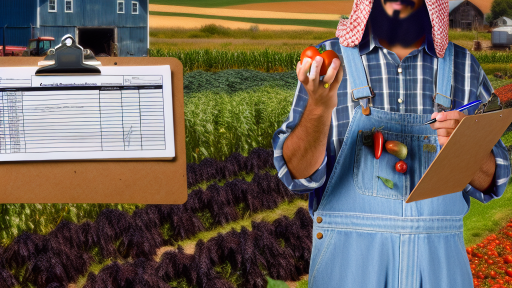Introduction to Crop Rotation
Importance of Crop Rotation
Crop rotation is vital for sustainable farming practices.
It helps maintain soil fertility and health.
Different plants have varying nutrient needs.
Alternating crops prevents nutrient depletion.
Moreover, it reduces soil erosion and compaction.
Farmers can manage weeds and pests effectively.
Crop rotation disrupts pest life cycles.
As a result, fewer herbicides and pesticides are needed.
Benefits of Crop Rotation
Implementing crop rotation delivers multiple advantages.
It improves crop yields over time.
Soil quality increases due to diverse root structures.
Crops such as legumes enhance nitrogen levels in the soil.
This practice fosters a balanced ecosystem on the farm.
Additionally, it provides market diversity for farmers.
Diverse crops can meet different consumer demands.
Transform Your Agribusiness
Unlock your farm's potential with expert advice tailored to your needs. Get actionable steps that drive real results.
Get StartedFarmers may access new markets with unique crops.
Understanding the Soil Ecosystem
The Role of Soil Health
Soyl health is vital for successful farming.
Healthy soil supports nutrient cycling.
It enhances water retention and drainage.
Furthermore, healthy soil encourages biodiversity.
Microbial activity in the soil adapts crop needs.
Impact of Crop Rotation on Soil
Crop rotation helps maintain soil fertility.
This method reduces soil erosion significantly.
It also minimizes pest and disease build-up.
Additionally, certain crops replenish nutrients.
For instance, legumes fix nitrogen in the soil.
Understanding Nutrient Cycling
Crop rotation aids in proper nutrient cycling.
Diverse root structures improve soil aeration.
Varying crops utilize different soil layers.
Consequently, the soil’s nutrient profile improves.
The Importance of Cover Crops
Incorporating cover crops enhances soil structure.
These plants prevent soil compaction and erosion.
They also contribute organic matter to the soil.
Moreover, cover crops suppress weed growth effectively.
Long-Term Soil Health Strategies
Developing long-term soil health strategies is crucial.
Farmers should monitor soil health regularly.
They can use soil tests to assess nutrient levels.
Adjusting crop rotation plans is often necessary.
Ultimately, sustainable practices yield thriving crops.
Showcase Your Farming Business
Publish your professional farming services profile on our blog for a one-time fee of $200 and reach a dedicated audience of farmers and agribusiness owners.
Publish Your ProfilePlanning Your Crop Rotation: Key Factors to Consider
Understanding Soil Health
Healthy soil is vital for productive farming.
It supports plant growth and yield potential.
Moreover, healthy soil promotes nutrient cycling.
Consider soil structure and microbiological activity.
Choosing Suitable Crop Varieties
Select crops based on their nutrient needs.
Diverse crops can enhance soil quality over time.
Incorporate legumes to fix nitrogen in the soil.
This helps to reduce dependence on synthetic fertilizers.
Incorporating Crop Diversity
Crop diversity mitigates pest and disease buildup.
Rotating crops alters the life cycles of pests.
This approach can lower pesticide usage significantly.
Timing Your Planting and Harvesting
Plan planting and harvesting schedules carefully.
Timing affects soil nutrient availability and moisture levels.
Seasonal adjustments can optimize growth patterns.
Evaluating Market Demand
Research market trends before finalizing your crop rotation.
Aim for crops that have strong market demand.
This ensures financial viability for your farming operations.
Monitoring and Adjusting Practices
Regularly assess your crop rotation results.
Adjust based on monitoring data and feedback.
This allows for continuous improvement in yields.
Stay flexible to adapt to changing conditions.
Discover More: Top Agri-Tourism Activities for Farm Visitors
Types of Crop Rotation
Introduction to Crop Rotation
Crop rotation involves alternating the types of crops grown in a specific field over time.
This practice enhances soil fertility and reduces pest populations.
Additionally, different crops contribute various nutrients to the soil.
Legume-Based Rotation
Using legumes in crop rotation promotes nitrogen fixation in the soil.
For instance, planting soybeans or peas improves soil health significantly.
Farmers benefit from reduced need for synthetic fertilizers.
Cover Crop Rotation
Cover crops protect the soil during off-seasons.
These crops prevent erosion and improve organic matter content.
Common choices include clover and rye.
Root Crop Rotation
Root crops like carrots and beets can improve soil structure.
They also help break up compacted soil layers beneath the surface.
As a result, other crops can thrive better in subsequent seasons.
Crop Diversity Benefits
Diverse planting reduces the risk of crop failure.
This approach also attracts a variety of beneficial insects.
Furthermore, it interrupts disease cycles, leading to healthier crops.
Economic Advantages of Crop Rotation
Crop rotation can increase farm profitability.
By integrating high-value crops, farmers enhance their market opportunities.
Additionally, it reduces long-term dependency on chemical inputs.
Showcase Your Farming Business
Publish your professional farming services profile on our blog for a one-time fee of $200 and reach a dedicated audience of farmers and agribusiness owners.
Publish Your ProfileEffective Crop Rotation Strategies
Implementing effective crop rotation strategies maximizes agricultural sustainability.
This practice ultimately fosters a more resilient farming system.
Farmers should consider various rotation methods tailored to their specific conditions.
Explore Further: Animal Welfare In Modern Farming
Integrating Legumes into Rotation: Enhancing Nitrogen Fixation
Understanding Legumes
Legumes are an essential part of sustainable agriculture.
They can improve soil health significantly.
These plants belong to the family Fabaceae.
Legumes have a unique ability to fix atmospheric nitrogen.
This process enriches soil fertility naturally.
Benefits of Nitrogen Fixation
Nitrogen fixation enhances plant growth.
It reduces the need for chemical fertilizers.
This leads to lower production costs for farmers.
Moreover, it helps in creating a balanced nutrient profile.
Crop Rotation with Legumes
Integrating legumes into crop rotation is invaluable.
This practice can enhance overall farm productivity.
Farmers should aim to alternate legumes with nutrient-demanding crops.
Crops like corn and wheat benefit from the added nitrogen.
Suitable Legume Varieties
Choosing the right legumes is crucial for success.
Popular choices include clover, peas, and beans.
Clover can be particularly beneficial for pasture land.
Peas are excellent for cool-season planting.
Beans provide high protein content and improve soil structure.
Implementing Legume Rotation Strategies
Farmers should develop a well-planned rotation schedule.
The rotation should account for various climate conditions.
Additionally, it is essential to monitor soil health regularly.
Soil tests can help in determining nitrogen levels.
Challenges in Legume Integration
Some farmers may face challenges in integrating legumes.
Pests and diseases can affect legume crops.
However, choosing resistant varieties can mitigate these risks.
Additionally, education and research are vital for overcoming obstacles.
Enhancing Small Farm Productivity with Legumes
Integrating legumes into crop rotation significantly benefits small farms.
This practice promotes healthier soils and sustainable farming.
Ultimately, farmers can enjoy enhanced productivity and profitability.
Discover More: Agri-Tourism Ideas to Boost Your Farming Business

Pest Management through Crop Rotation
Understanding Crop Rotation
Crop rotation involves alternating different crops on the same land over seasons.
This practice disrupts pest life cycles effectively.
It also reduces soil nutrient depletion.
Farmers can implement a rotation schedule tailored to their crops.
Benefits of Crop Rotation for Pest Control
One key benefit is reduced pest populations.
Different crops attract different pests.
Showcase Your Farming Business
Publish your professional farming services profile on our blog for a one-time fee of $200 and reach a dedicated audience of farmers and agribusiness owners.
Publish Your ProfileBy rotating crops, you break the cycle of pest infestation.
This disrupts their habitat, leading to natural populations declining.
Specific Strategies for Effective Rotation
- Alternate between legumes and non-legumes.
- Incorporate cover crops during off-seasons.
- Utilize companion planting to repel pests.
Implementing a mix of these strategies increases soil health.
Healthy soil fosters better crop growth and yields.
Monitoring and Adapting Your Rotation
Regular monitoring is crucial for effective pest management.
Farmers should assess pest populations annually.
This data helps adjust future crop rotation plans effectively.
Adaptation is key to successful long-term pest control.
Community and Resource Support
Local agricultural extension services provide valuable advice.
Joining farming cooperatives can also offer support.
Sharing experiences with other farmers enhances learning.
Utilizing online resources can keep you updated on best practices.
See Related Content: Enhancing Customer Experience in Farm Sales
Seasonal Considerations: Timing Your Crop Cycles for Maximum Yield
Understanding Seasonal Patterns
Understanding seasonal patterns is crucial for farmers.
Different crops thrive at different times of the year.
For instance, cool-season crops like broccoli grow well in spring and fall.
On the other hand, warm-season crops like tomatoes prefer summer.
By recognizing these patterns, farmers can plan effectively.
Optimal Planting Times
Timely planting is essential for maximizing yields.
Farmers should consult local agricultural extension services.
These services provide valuable insights into planting calendars.
Additionally, utilizing weather forecasts can aid in decision-making.
Farmers might also consider planting dates based on soil temperature.
- Most seeds germinate well at optimal soil temperatures.
- Keeping track of frost dates helps avoid crop damage.
- Seasonal rainfall patterns impact planting schedules.
Crop Rotation Benefits
Crop rotation enhances soil health and productivity.
It minimizes pest and disease cycles, promoting healthier crops.
Implementing a diverse crop rotation can yield several benefits.
- Different crops utilize various soil nutrients.
- Rotating crops reduces nutrient depletion.
- Diverse crops can improve soil structure and fertility.
Farmers can plan their rotations based on seasonal growth cycles.
Utilizing Cover Crops
Cover crops are valuable for seasonal farming practices.
They protect soil during off-seasons and prevent erosion.
Additionally, cover crops can enhance soil fertility naturally.
For maximum effectiveness, choose cover crops suited for your region.
- Clover and vetch add nitrogen to the soil.
- Rye and oats suppress weeds and improve soil structure.
Monitoring and Adjusting Plans
Continuous monitoring of crop performance is vital.
Farmers should observe weather variations and their impacts.
Adjustments based on these observations can improve outcomes.
Record-keeping allows for informed decisions in future seasons.
Engaging with local farming communities can provide additional insights.
Evaluating Your Rotation Strategy
Importance of Monitoring Outcomes
Monitoring your crop rotation outcomes is essential for effective management.
It helps identify which crops thrive in specific conditions.
Additionally, monitoring allows you to see pest and disease patterns.
Assessing Soil Health
Regular soil tests provide valuable insights into nutrient levels.
Showcase Your Farming Business
Publish your professional farming services profile on our blog for a one-time fee of $200 and reach a dedicated audience of farmers and agribusiness owners.
Publish Your ProfileThese tests can reveal changes in soil pH and organic matter content.
Acting on this data will enhance your soil health over time.
Adapting to Changes
Climate conditions can vary each season, affecting crop performance.
Therefore, be prepared to adjust your planting schedule based on weather.
Flexibility in your strategy can lead to better yields.
Gathering Data on Crop Performance
Keep detailed records of each crop’s yield and quality.
Comparing these records year by year helps identify trends.
This data plays a crucial role in refining your rotation strategy.
Implementing Feedback Loops
Create systems for regular feedback on your crop rotation decisions.
Engage with local agricultural organizations for support.
They can offer advice based on regional successes and failures.
Continuous Learning and Experimentation
Stay open to learning from both successes and failures.
Experimenting with new crops or techniques can yield surprising benefits.
Over time, adapt your practices based on what proves most effective.
Additional Resources
Farmer in Chief – Michael Pollan
Crop Rotation Effects on Soil Fertility and Plant Nutrition – SARE




